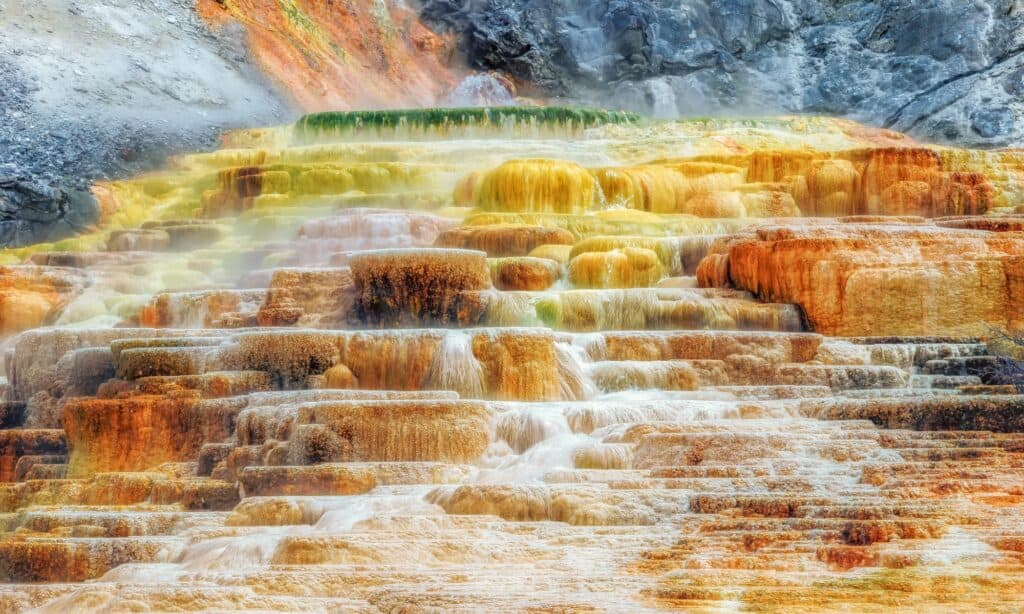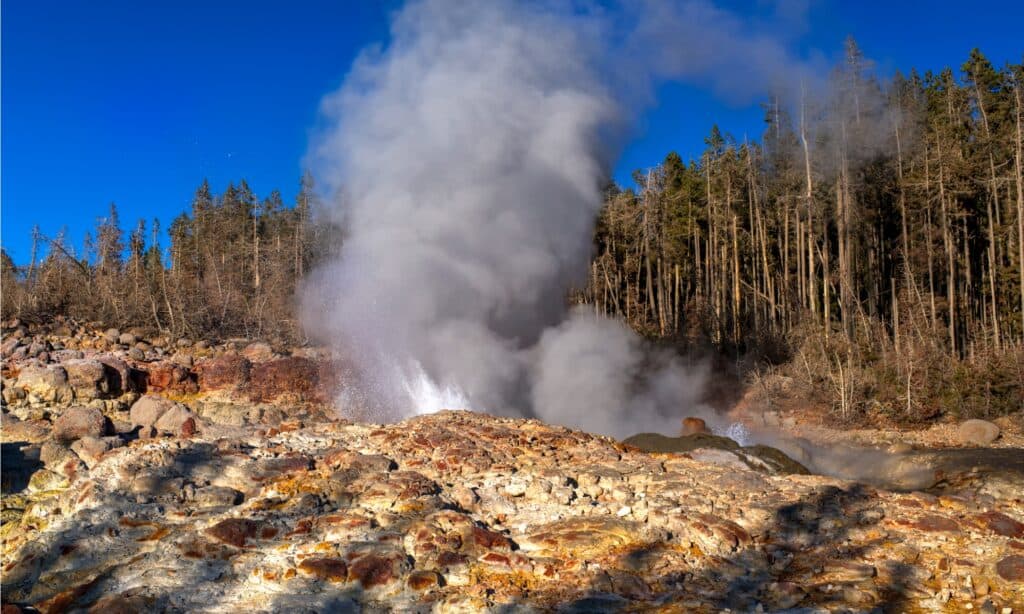If you are just beginning to learn about some of the most popular National Parks in the United States, you may be wondering: is Yellowstone an active volcano? Perhaps you have already started your research and stumbled across some information that addressed the fact that Yellowstone National Park is formed atop multiple calderas- but are they still active?
In this article, we will go over some important information regarding the Yellowstone volcano and what to expect in terms of a potential eruption. What are the chances of this volcano erupting in the future, and what would it do to the greater Yellowstone ecosystem? Read on to learn more about Yellowstone National Park being an active volcano now!
Is Yellowstone National Park an Active Volcano?

Yellowstone still remains the site of an active volcano, if not multiple active volcanoes.
©iStock.com/BigshotD3
Yes, Yellowstone National Park is technically still an active volcano. Formed over 2 million years ago from multiple violent volcanic eruptions, Yellowstone still remains the site of an active volcano, if not multiple active volcanoes. In fact, there are at least 3 separate caldera locations within the boundaries of Yellowstone National Park, all forming millions of years ago!
For example, the first large-scale eruption occurred roughly 2.1 million years, while the next largest occurred 1.3 million years ago. Finally, the third supervolcanic eruption happened roughly 630,000 years ago- far more recent than its predecessors! These three eruptions formed calderas and altered the landscape of Yellowstone irrevocably.
But what do these eruptions and calderas mean for the future of Yellowstone National Park, and what should you know for your own safety when visiting the park? Let’s talk about that now.
How Many Volcanic Eruptions Have Occurred in Yellowstone?

In addition to the already-formed volcanic features found throughout Yellowstone, there are some features that are constantly shifting and changing due to volcanic activity.
©Susanne Pommer/Shutterstock.com
Besides the three larger eruptions already listed, there have been roughly 80 smaller volcanic eruptions recorded in the history of Yellowstone National Park. All of these eruptions have had an effect on Yellowstone’s formation and unique features, including forming lakes, rivers, and unique volcanic rock features.
In addition to the already-formed volcanic features found throughout Yellowstone, there are some features that are constantly shifting and changing due to volcanic activity. For example, magma located just below the surface of the earth exists, forming some locations that shift and change with the flow of magma.
The volcanic activity occurring just beneath the surface of Yellowstone National Park is so prevalent that the topography and landscape of the park is shifting. Inflated magma pools beneath the earth have moved the water levels of Yellowstone Lake dramatically to the south, overtaking forested areas of the park and creating new shores in the northern regions of the lake.
Where Can You See Volcanic Evidence in Yellowstone?

Some of Yellowstone’s most popular landscape features include these volcanic beauties.
©iStock.com/lucky-photographer
There are a number of locations where you can see volcanic evidence in Yellowstone National Park, especially when you consider the fact that the canyons, lakes, and geysers were all technically formed by these ancient supereruptions! If you are planning a visit to Yellowstone, you can easily see the following volcanic features in the park:
- Basalt
- Ash flow and deposits
- Lava flow
- Tuff (volcanic ash rocks)
- Rhyolite
- Caldera rims, basins, and other features
Some of Yellowstone’s most popular landscape features include these volcanic beauties. When you think of Old Faithful, it’s difficult to think about this geyser without considering the volcanic activity propelling water up into the air! If you are interested in seeing any of these features, you can check them out in the following locations:
- Firehole Canyon- lava flows along the Firehole River
- Lewis Falls- close enough to the Caldera rim for a good look
- Washburn Hot Springs Overlook- a fantastic view of the Caldera and a resurgent dome
- Obsidian Cliff- lava flows are possible here
- Gibbon Falls- Check out the Caldera rim from this spot
- Tuff Cliff- unique ash flows and rock formations
- Sheepeater Cliff- beautiful columns of basalt form unique structures
Again, there’s no shortage of volcanic evidence or activity in Yellowstone National Park. While you won’t see active lava flows during your time, you can see the evidence of volcanic supereruptions long past!
What Would Happen if Yellowstone Had Another Volcanic Eruption?

Many studies note the fact that the Yellowstone caldera is unlikely to erupt in our lifetime, let alone in the next few centuries.
©iStock.com/SergeYatunin
There’s no telling what exactly would happen if Yellowstone had another volcanic eruption. Thankfully, many studies note the fact that the Yellowstone caldera is unlikely to erupt in our lifetime, let alone in the next few centuries. Yellowstone National Park employs a number of people to track and study the volcanic activity in the park, and there is no evidence to suggest an eruption is anywhere close to happening.
Volcanoes have a lifespan, or a certain amount of lava available beneath the surface of the earth. Yellowstone may not have enough life or lava left in the tank to fuel another supereruption! However, it’s always safe to consider all of the potential options, including the worst: what would happen if Yellowstone did indeed erupt?
Some studies suggest that the entirety of the United States would be coated in ash, with the nearby states of Montana, Wyoming, and Idaho suffering huge piles of ash for weeks following the eruption. While ash may not sound all that bad, the locations closest to the volcano would experience nearly 5 feet of ash based on how much ash fell during past supervolcanic eruptions. This much ash is enough to do some serious damage, both to infrastructure and innocent lives!
No matter how terrifying the outcome of a volcanic eruption may be, Yellowstone National Park exists to celebrate the volcanic activity bubbling just beneath the earth’s surface. Given the fact that there’s no eruption expected in the next few centuries, why not check out what makes Yellowstone so special and plan a visit?!
The photo featured at the top of this post is © iStock.com/SergeYatunin
Thank you for reading! Have some feedback for us? Contact the AZ Animals editorial team.







